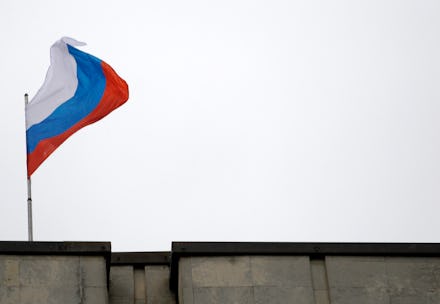This Is the Flag Flying Over Southern Ukraine Today

In Kiev, pro-Russian president Viktor Yanukovych has been ousted from power and the opposition leaders are already in the process of selecting candidates for the new government. But elsewhere in Ukraine, the conflict is far from over.
Image credit: AP
What is happening in the Crimea? The struggle between pro-Western and pro-Russian forces reached a fever pitch on Thursday when gunmen initiated a hostile takeover of government buildings in the Crimean region. At the regional capital, Simferopol, the men occupied the parliament building, hoisting the Russian flag and putting up a sign that read, "Crimea is Russia."
Though the gunmen have not made any demands yet, the parliament's website and phone lines are down. The police have attempted to enter the building, but it's been barricaded from within. When a journalist attempted to approach with questions, the gunmen threw a flash grenade.
The takeover came days after thousands of ethnic Russians protested in the streets against the new government in Kiev, leading to an angry clash with the ethnic Tatars. Two people died, and more than 30 were wounded from the confrontation.
Why is there a conflict? The ethnic Tatars in the region support Ukraine's opposition leaders, while the ethnic Russians either want a pro-Russian Ukraine or their independence.
With Yanukovych's ousting, the opposition leaders have the opportunity to form a new government that leans towards the EU and the West. But this is not welcome news to the ethnic Russians, who consider themselves closer to Moscow. This struggle is what led to the Ukrainian protests in the first place.
Image credit: AP
What is the background for this conflict? The Crimea only became a part of Ukraine in 1954, when Soviet leader Nikita Khrushchev transferred it under his power. It is the only region of Ukraine where ethnic Russians outnumber other ethnic groups, though there is are significant Russian populations in other regions.
The Muslim Tatars, on the other hand, were deported from the region during World War II by Josef Stalin, and were only able to return to their homeland following the collapse of the Soviet Union in 1991. So the conflict between these two forces is not only an ideological one, but also an ethnic, sociocultural, religious and linguistic one.
Image credit: AP
What will happen next? Across western Russia, President Vladimir Putin has been putting the military on alert. About 150,000 troops have been conducting exercises to "check the troops' readiness for action in crisis situations that threaten the nation's military security." The Russian government has also offered protection to Yanukovych, who is currently hiding in Russia, but still considers himself the legitimate leader of Ukraine.
The U.S. has warned Russia that any kind of military intervention in Ukraine would be a "grave mistake."